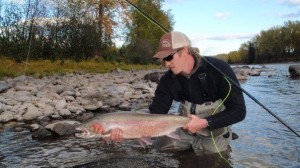Today we are featuring an archived article done by steelhead expert Matt Sharp. No matter the level of experience, whether a beginner or cagey veteran, you will learn something that will help you get hooked up on steelhead by reading this. Enjoy!
Winter Steelhead Techniques
Fishing for winter steelhead with a fly is one of the most daunting challenges of our sport. Anglers can spend years waiting for that first wondrous pull. There are a number of successful techniques but the swung fly has become the most commonly used. Let’s take a moment to look at why this simple technique is the method of choice and should be the prime focus for anglers.
Reason 1 – It is simple. It can be repeated thousands of times with little need for variation.
Reason 2 – It covers large stretches of water quickly and thoroughly.
Reason 3 – The act of swinging a fly perfectly imitates wild prey species. Immature salmon, small trout, ditch eels and leaches will instinctively turn up stream and fight against the current as they move to the safety of shallow water. Watch the salmon fry in your local river. The swing is a perfect imitation of this behavior and one of the most effective predatory triggers.
Reason 4 – With a swing, the angler maintains direct contact with the fly. Recognizing a take is simple when the rod tries to jump from your hand. This immediate feedback will help you gain the experience needed to become a successful steelheader.
Some will argue that techniques like nymphing and indicator egg fishing are more productive but understanding how to mend through a run, recognizing the strike and then reacting to it after hours with no action, takes skill and experience. Using an egg, I have watched novice and experienced anglers alike miss strikes without realizing that a fish has taken their presentation. The river only knows how many times I have been fooled.
Keys to Fishing the Swung Fly
Water Speed:
Find runs that have walking pace current in depths from 4 to 6 feet. This is perfect steelhead holding water but more importantly, it is water where they are most likely to see a natural salmon fry, leach or ditch eel making a move across the river.
Structure:
Look to the shore. The rocks on the shore are a good indication of what lies beneath the water. If head size boulders litter the shore, it is a good place to start. Ideal steelhead holding water contains head size rocks with the odd suitcase size boulder breaking up the flow.
The Swing:
Now that we have found ideal water, let’s look at the simple mechanics of the swing.
The angler casts somewhere between 90 degrees cross steam to 45 degrees down stream. Between the 90 and 45 degree mark, the angler should make an aggressive mend up stream. This dead drifts the fly, allowing it to sink. At 45 degrees, the fly begins to swing.
Use your trigger finger to maintain direct contact with the line. Follow the swing with your rod pointing to the fly. Hold the tip a foot off the water and try to keep subsequent mends and rod movement to a minimum.
When the line straightens out down stream, let the fly dangle for a good 5 seconds. Once again, this imitates natural prey behavior. Your fly has just made a harrowing escape from the heavy water and is settling in slower, safer holding water. You will be surprised how many fish take during this dangle.
After five full seconds, begin stripping. Make the first two or three pulls with a tentative movement. The odd fish will hit as the fly begins to pull away.
Covering Water:
With the fly retrieved, take 1 to 4 steps down stream (2 – 6 ft) and repeat the process. This act of moving through a run is just as important as the cast and swing. All experienced steelheaders understand that the more water they cover, the better their chances. For a more detailed explanation of how to move through a run, look for the article: “Understanding the Steelhead Shuffle” in our next news letter.
Depth Control:
For winter steelhead in water temperatures of 49 degrees and below, the key is to keep the fly as close to the bottom as possible. With modern fly equipment, we have a variety of tools to help us achieve this goal. Within your arsenal, you should have type 3, 6 and 8 sink tips. I recommend the 15 ft length. I find that the type 6 is most commonly on the end of my line and is usually a good place to start. It is also an idea to take advantage of T14, Rio’s most aggressive sink tip material. Have two “heads” of T14 in ten and fifteen foot lengths.
When first learning a run, try to go as deep as possible. Once you begin to snag, lighten your presentation. Snagging once within every ten casts as you move through the run will ensure you are close enough to the bottom.
When that first spine tingling tug comes, stay calm and don’t set the hook. Let the steelhead take and turn on the fly. Slowly raise your rod. With the rod 45 degrees off the water and the fish still showing good solid tension, make a short firm hook set and let the fun begin.
Recommended Gear
Rods: Single hand: 7 – 9 weight in the 8 to 10 foot range & Spey Rods: 7-9 wt 10-15ft
Lines: Shooting heads and sink tip lines 7-9
Reels: Something that can handle at least 150 ft of backing. Staff Favorites: Nautilus, Islander, Waterworks, Sage, Redington & Abel
Leader: 3.5 – 5ft of 8-15 lb. Staff Favorites: Maxima, Maxima, and more Maxima
If you have any steelhead questions please do not hesitate to drop by Pacific Angler or contact me or one of the friendly staff at the store at 604-872-2204.
Tight Lines,
Matt Sharp





